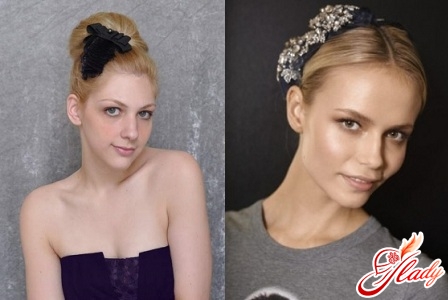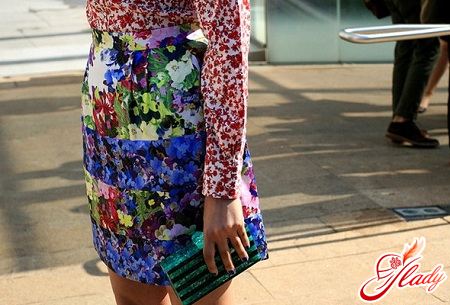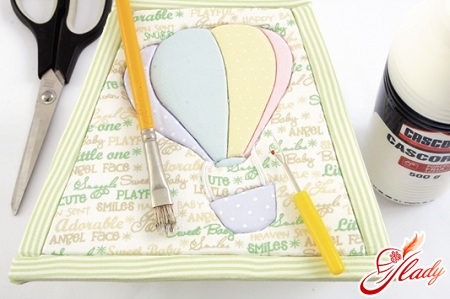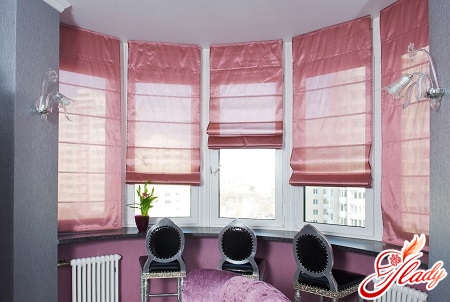
Roman curtains used in Europe alreadyseveral centuries, appeared relatively recently in Russia and immediately gained immense popularity due to its simplicity and functionality. We will show you how to sew a Roman curtain. Such curtains, sewed from a piece of fabric and similar to waves, can be made by yourself at home. In order to sew Roman blinds with your own hands, decide how you want to place them on the window: inside the opening or outside? If inside the opening - then the curtain will be near the glass. Outside - then the piece of fabric should be larger than the opening of the window by 7-10 cm to the left and to the right. In this case, the cutting principle is the same. Have removed the sizes and now think, whether there is no at you a beautiful cut of a fabric which long lays idle? Excellent thick fabric, for example, drape, but not easy material with a catchy pattern. Do not forget, the Roman curtain should be with a beautiful wave, an easy form of fabric will not hold, and a bright picture will not look at all at the window. If you did not find the house, look in the store. Try to choose a material with a complex weave. This will not cost much, as the tissue is required at a minimum. If you decide to do everything yourself, then the design of the Roman curtains must also be made by you. If you for some reason do not want to do it, the store sells ready-made designs. List of required materials:
Step-by-step instruction for making Roman curtains
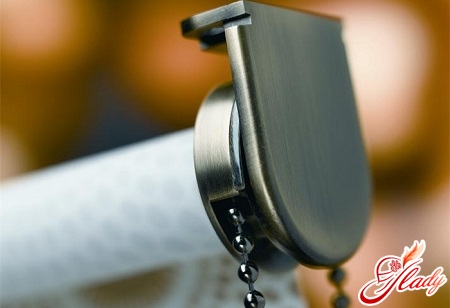
Roman blinds without laths
Roman curtains without the use of racks - it'sthe very first version of these curtains. In this case, you need two beams, the upper and lower, cords and, most importantly, a double curtain. Do everything as described above, but instead of the sections sew the rings. The most extreme - 4 cm from the edge of the sidewall. Then you can experiment. You can sew one ring in the middle. Sew the cords in a known way. If you need more rings, calculate the distance between the cornice and the cords. You will only have to sew a tape, Velcro, and the curtain is ready. How to sew a curtain using a decorative edge You can decorate a curtain made with your own hands with edging. Make it curly or straight, but strengthen with a dublerin or non-woven fabric. Sew a curtain over the lining. From the duplicating fabric, cut the piece along the finished edging and glue it to the front surface from the wrong side on the bottom. Do not forget to leave room for allowances. Then top the fabric and lining with a bag, iron, cut corners, fillets are incised. Turn out, once again iron. At the top of the decorative edge, attach a cloth 3 cm wide (kulisk under the bar). Do not put one side on the side. Make markings as usual, but take the distance from the kuliska to the top. Make the edge more than half of the section, otherwise it will simply not be visible.
How to sew Roman curtains with your own hands
You can do without the use of braid, and makedecorative protectors on the front or on the underside and insert racks in them. In this case, face protectors will become a decoration for curtains, and purl prints will make folds ideal. Before cutting, calculate the number of sections, multiply the result by 1.5 and add up to 15 cm left on the height allowance. In this case, take a single tissue. Blind in almost finished form (bent top and bottom) is marked, it is taken away 3 cm of the kulisks and the width of the sections is calculated. To mark it is necessary from below, from the kuliska, draw the section line, then 1.5 cm of the guard, again the section, 1.5 cm - the guard, and so on. Lines on the fabric are made from the side where you will have the defenses. Fold them in half, pin with a pin and sew. Treat the finished curtain with an iron and sew a velcro tape. 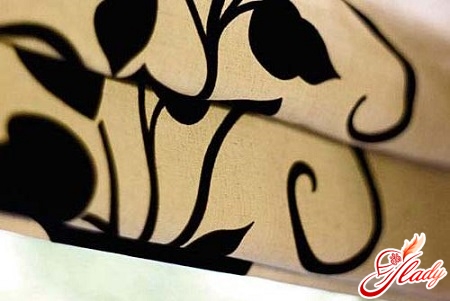
How to fix possible errors
If the sides of the curtains are warped, you have not checkedthe fabric is skewed. But even if there was no skewing in the fabric, it is extremely important to use a ruler when cutting and observe right angles. If the side seams have shrunk, sewing was poor, check the thread tension in the sewing machine. Another reason can be too careful ironing the seams. Fabric in these places can sit down under the influence of high temperature. The transverse tape was pulled together because you did not attach it with pins or processed it with an iron before sewing. Always do this in advance, since the braid is made of synthetic fibers and, when processed further, the iron inevitably sits. Ribbed sides arise if the material is stretched under the tape. In such cases, you should rasporot and do all the work again. The lining of the double curtains stretched, and the front side covered with bubbles. Note that the lining is made of synthetics, and before sewing it must necessarily be treated with a hot iron. The front part, on the contrary, is often made of natural material. Before cutting, do not be lazy, soak the cloth in hot water. There will be a necessary shrinkage, and such troubles will not arise. 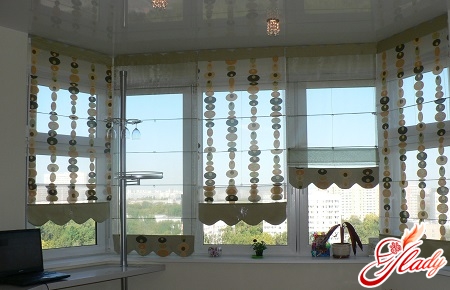
Application of Roman curtains
Roman curtains can decorate any interior. These curtains will look great in any style of the interior. In the classical style, they only emphasize the beauty of the lines. In the bohemian interior will help to muffle arrogance. In the high-tech style, their application can become a very original solution. Look beautiful such curtains in the kitchen, when the usual curtains are boring, and you want something new. This is an ideal option for windows of small size, but also on large windows they look appropriate, they just need to have rows. You can hang such curtains not only on the windows, but also on the interior doors. And if you're at home with children, organize a children's theater, then the Roman curtains will play the role of a screen. If you want to use Roman curtains in your bedroom, you can adjust the level of illumination. In those cases where the bedroom is small, make the curtains in tone to the color of your walls. This method increases the room. And curtains should not be very dense. Broken lighting will give volume to a small room. For the living room, choose thick fabrics. Very nice look Roman curtains in combination with long curtains, but if the room is small, leave only the Roman curtains. If you pick up Roman curtains in contrast to the surroundings, this will add to the solemnity of your living room. Roman curtains in the kitchen should be combined with decor elements. But if you are a happy owner of a large kitchen, then you can experiment. With windows facing north, the curtains should be light shades and medium density. The most practical materials for kitchen curtains: cotton, linen and mixed fabrics. In the children's room you can often see very bright curtains with drawings. It's a big mistake to use such curtains for a nursery. For the child's psyche is an unfortunate option. If you want brightness, choose single-color curtains. And the best way is to sew Roman curtains yourself. Remember: yellow color - adds a good mood. Orange - activates. Blue and blue - soothe. Green - relieves fatigue. Roman curtains have found their application in any style, in any setting they look harmonious and elegant. 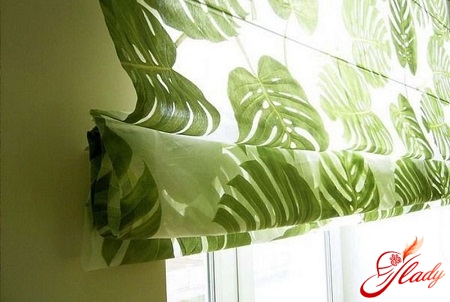
Roman curtains and hi-tech style
The style of hi-tech is notable for its restraint,functionality, practicality. For someone, it seems daring and defiant. Shades of color should meet the same requirements. This style is accompanied by the following colors: all shades of gray, black, white, brown. Olive and swamp colors can be used. Adhering to this style in the interior, you should not mix more than two colors. Metal decorative elements are welcomed. Fabrics should be heavy, dense, with a metallic luster. You can also use natural materials: natural and artificial silk, satin, satin and linen.
Roman blinds and country style
The country style is distinguished by comfort, special comfort. Interior in the style of country like those who are tired of the city bustle and wants to create in their home the situation of their childhood. In this style, it is appropriate to use all sorts of appliqués and embroideries. The use of curtains in this style must adhere to certain rules: French country - cloth should be with small flowers; American country - on the cloth are flowers, but larger and bright; African country is a material with large colors and very bright shades. In this style, natural fabrics are used: cotton, linen, chintz. You can use artificial materials. It looks good in this style of the interior of the patchwork technique. Sewing pieces of fabric and making an original drawing, you can decorate such a curtain any window. You can make knitted curtains and decorate them with wood or ceramics.
Roman curtains and classic style
Classical style is used not only in homes,but also in offices. It is very popular in large companies and financial institutions. Using this style, they usually want to emphasize their importance, stability and tradition. Curtains, sustained in this style of interior, should be elegant, combine traditions and modernity. Material for curtains: cotton, viscose, linen. From heavy fabrics are used: velvet, jacquard, velor. The color is better to use closer to the natural. It can be shades of blue, green, yellow, beige. In the classical style, a noble brown is often used. Using Roman curtains for the classic interior, try to make the curtains emphasize the overall gamut of the room, rather than stand out as a separate spot.
Roman curtains and ethnic style
Ethnic style in the interior always expressesculture and color of one people, rich in traditions. In the interior, there are usually numerous drawings, fabrics and things that characterize the way of life of this people. Japanese and Chinese colors in the interior can be expressed in the use of silk and satin fabrics of blue, red and even black colors, painted with hieroglyphics. Scandinavian style is characterized by asceticism, coldness and consistency. Fabrics for curtains are selected matching: colors from terracotta to white. At first glance these are rough and simple fabrics, but the first impression is deceptive. This style uses high-quality natural materials. African color in the curtains is expressed in brown and green. Usually, preference is given to flax fabrics of deep saturated shades.
Roman curtains and eclecticism
This style is able to combine in itselfincompatible things. The scattered space suddenly, thanks to such details as curtains, turns into a harmonious whole. In this style, people like communicating, mobile, modern people like to live. In the design of this style can combine completely incompatible with each other furniture, household appliances, but thanks to the applied color solutions, thanks to the smooth lines and applied textiles, this whole space is combined into one. Curtains in this style play a very important connecting role. Usually Roman curtains of dense materials are used, and whole clouds of tulle, organza or veil supplement them. Roman curtains in this interior are often complemented by brushes, beautiful fringe or ribbons.





